The Smithsonian Reveals the Glamorous Wardrobe Secrets of America’s First Ladies
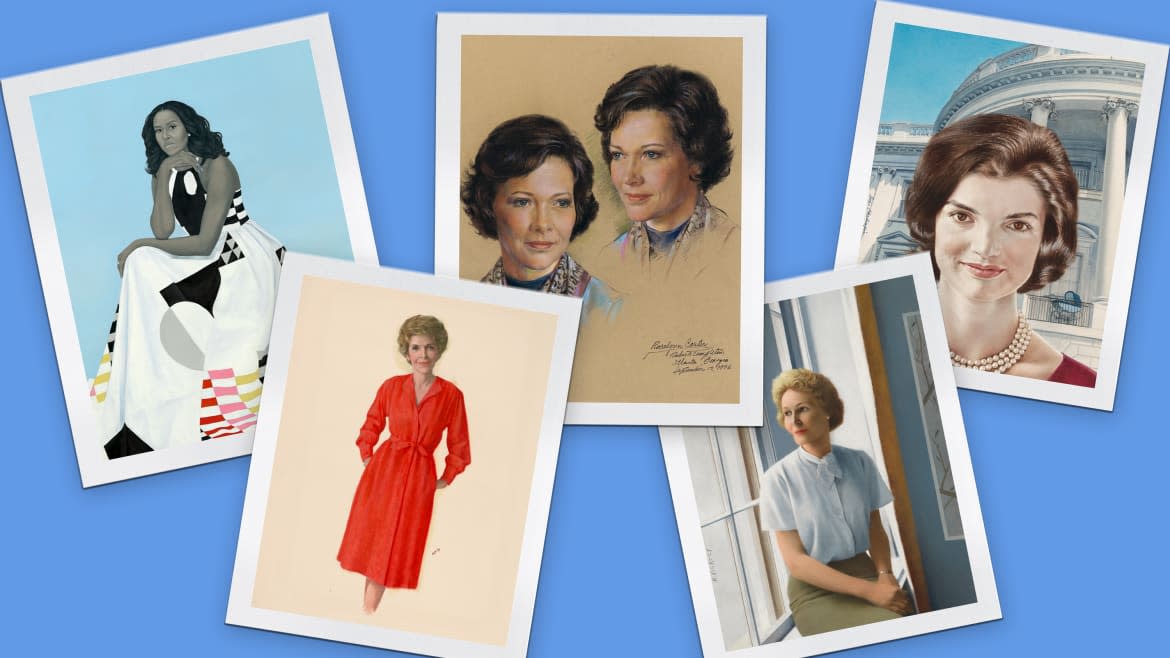
Mary Todd Lincoln had the misfortune of being an ambitious woman during a time when she was expected to be mere adornment—and it made her miserable. History recalls the first lady as a moody one, perhaps due to an undiagnosed, much-speculated-about mental illness (the way she was lambasted by the press certainly did not help). So this unhappy woman who lived over 150 years ago did what many modern ones do when they get the sads: She shopped.
“Frustrated in with her own goals, married to a man who was able to take her to the place she wanted to get—the ultimate seat of power—but still unhappy, Mrs. Lincoln put a lot of energy into buying jewelry and having dresses made,” Gwendolyn DuBois Shaw, senior historian at the National Portrait Gallery, told The Daily Beast. “She would go to her dressmaker, Elizabeth Keckley, and order 15 dresses at a time. It would take months for Keckley to make them all.”
One of those pieces, a rose pink capelet with black lace detailing at the neck, is part of “Every Eye Is Upon Me: First Ladies of the United States,” a new exhibit at the Smithsonian National Portrait Gallery. The show is the museum’s first-ever attempt to center the stories of the presidents’ wives. It opened in D.C. and online this week, and explores the lives of everyone from Martha Washington to Melania Trump through portraiture, plus a few items of clothing.
When Mary Todd Lincoln’s Son Had Her Declared Insane
The pieces were pulled from a variety of sources—the National First Ladies Library, presidential libraries, private collections, and the White House, which loaned an “unprecedented” 12 portraits to the exhibit. Kim Sajet, the director of the National Portrait Gallery, said the museum “literally could not have done it without them.” Many of the portraits on display are usually kept in private meeting rooms in the White House.
The White House Office of the Curator helped facilitate this process. Shaw, the senior historian, called the office that is charged with the conservation of fine art used to decorate the residence a “standalone” team that does not necessarily change staff from administration to administration. (The current curator, Lydia Tederick, was appointed by Trump but has worked in the office since 1979.)
The White House Historical Association, itself founded by Jackie Kennedy during her time at first lady, also assisted in reframing and cleaning artwork. A portrait of Melania Trump hangs in the exhibit; it was provided by her staff.
“They printed it and framed it to Mrs. Trump’s liking, and sent it over to us to hang,” Shaw said.
Clothing from the 19th century, such as Lincoln’s capelet, can be hard to authenticate, Shaw said. She found the piece while visiting the National First Ladies’ Library in Canton, Ohio. The curator there told Shaw she had a Keckley original. “I thought, ‘You do?!?’” Shaw recalled. “I wanted something that really tells a story.”
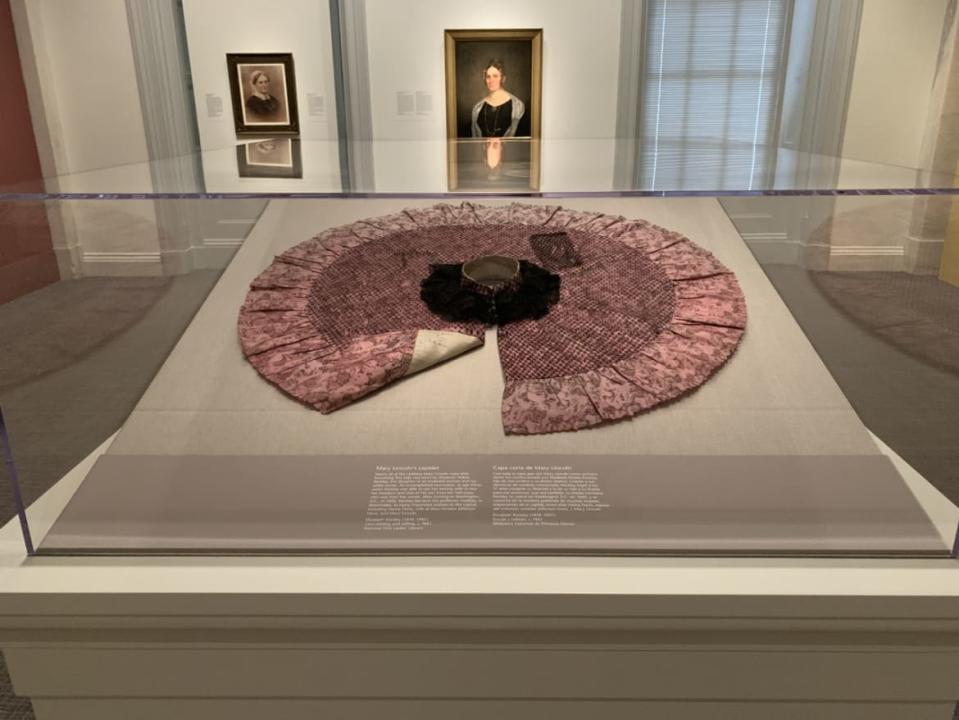
Mary Todd Lincoln’s capelet by Elizabeth Keckley, circa 1861.
And this cape sure does. It was made by Keckley, who became Lincoln’s official modiste, or dressmaker, by sheer force of will, plus a lot of financial savvy. Born in Virginia, the daughter of an enslaved mother and the white planter who owned her, Keckley survived a brutal upbringing of abuse and rape. She was eventually owned by her half-sister, Anne Garland, and her husband.
“In many ways, Keckley’s story reflects a lot of other experiences of enslaved people who worked literally around the clock to save money to buy their freedom,” Shaw said. “She bought her freedom from her own half-sister, which is heartbreaking.”
In 1855, Keckley paid $1,200 to get herself and her son out of slavery, then moved to Washington, D.C., to become a dressmaker. She always had a talent for sewing and was quickly a go-to for many fashionable wives of powerful men—including the spouses of future Confederate leaders Sen. Jefferson Davis and Robert E. Lee.
She met Lincoln upon her husband’s inauguration; the two became quick confidants. “Lincoln poured her heart out to Keckley and they found an affinity, a kind of friendship,” Shaw said. “I don’t think we should underestimate the power dynamics that were still present in the relationship. These women were not equals, but they were able to have a strong relationship.”
The two understood each other, Shaw added. Keckley modernized Lincoln’s wardrobe, dressing her elegantly, putting her in vertical stripes to make her appear taller and slimmer. The morning after President Lincoln was assassinated, his mourning wife requested that Keckley come to her quarters.
Such is the relationship between first ladies and their image-makers. “When you stand in your underwear with somebody talking about how you want to look for the world when you put your clothes on, you can develop a very close relationship,” Shaw said.
Such was the case with Nancy Reagan, a physically tiny woman who manifested ’80s excess in her unabashedly gilded, glamorous wardrobe often courtesy of designer James Galanos. She rarely wore the same dress twice, infamously accepted thousands of dollars worth of free designer swag, and spent $10,000 on her Galanos-designed 1981 inaugural gown.
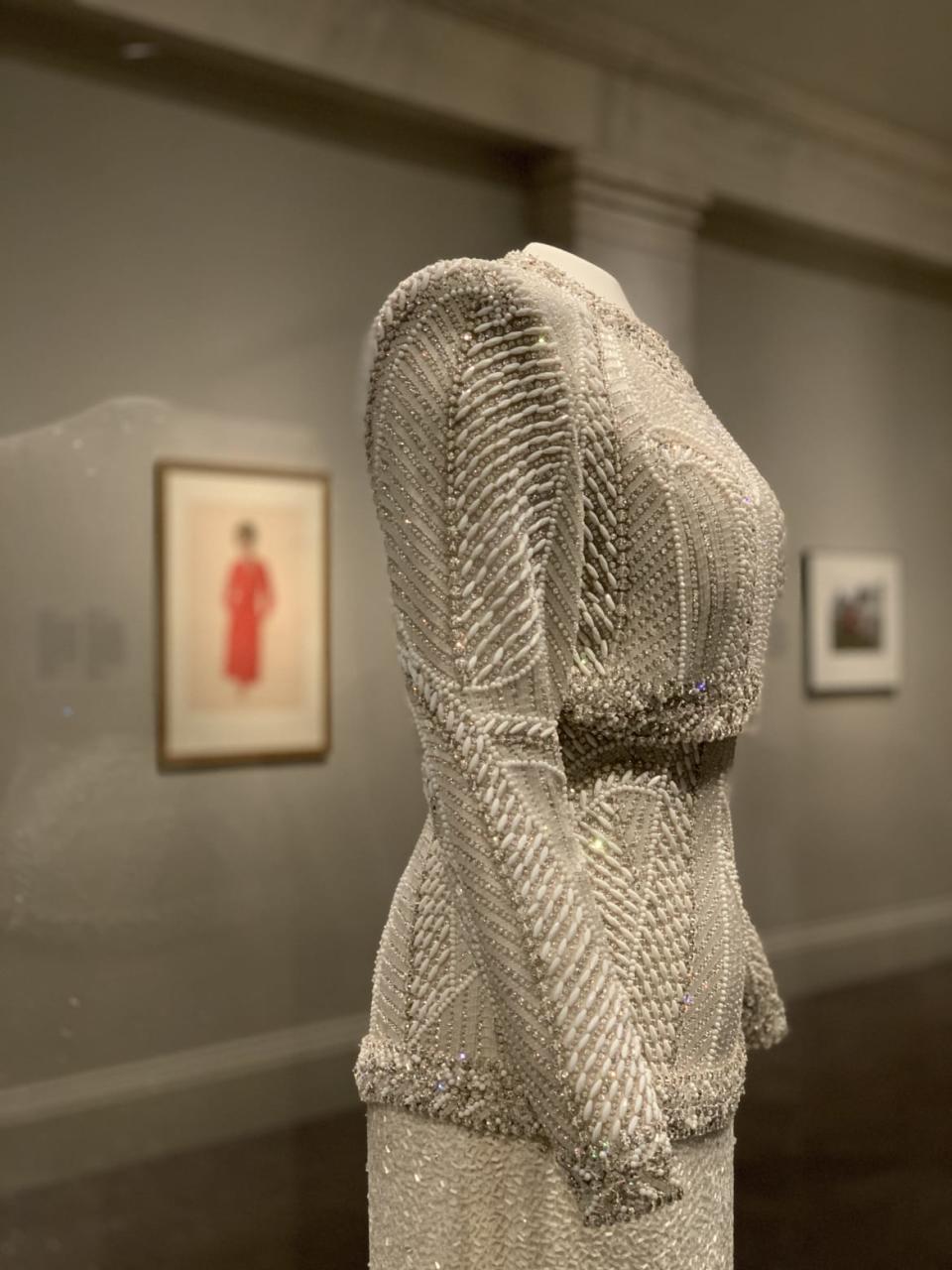
Nancy Reagan’s 1985 inaugural gown by James Galanos.
Four years later, she would wear another Galanos original to celebrate her husband’s re-election. With its big, padded shoulders and A-line cut, the gown perfectly fit her size 2 frame. It reportedly took 300 hours to embroider the chiffon with glass beading, and the dress is included in the exhibit.
The son of Greek immigrants who lived in Los Angeles but was always compared to details-obsessed French couture designers, Galanos also became a close friend of Reagan. Shaw spoke to Nancy’s son, Ronald Reagan, Jr, who said his mother simply called the dressmaker “Jimmy.”
“He knew her body down to the millimeter,” Shaw said. “And everything fit her exactly as she wanted them to. This dress weighs about 20 pounds, and Nancy was just a petite, petite woman. She was walking around in this suit of sparkly armor.” This was the rare outfit she repeated, wearing it again when Princess Diana visited the White House in 1985 and iconically danced with John Travolta.
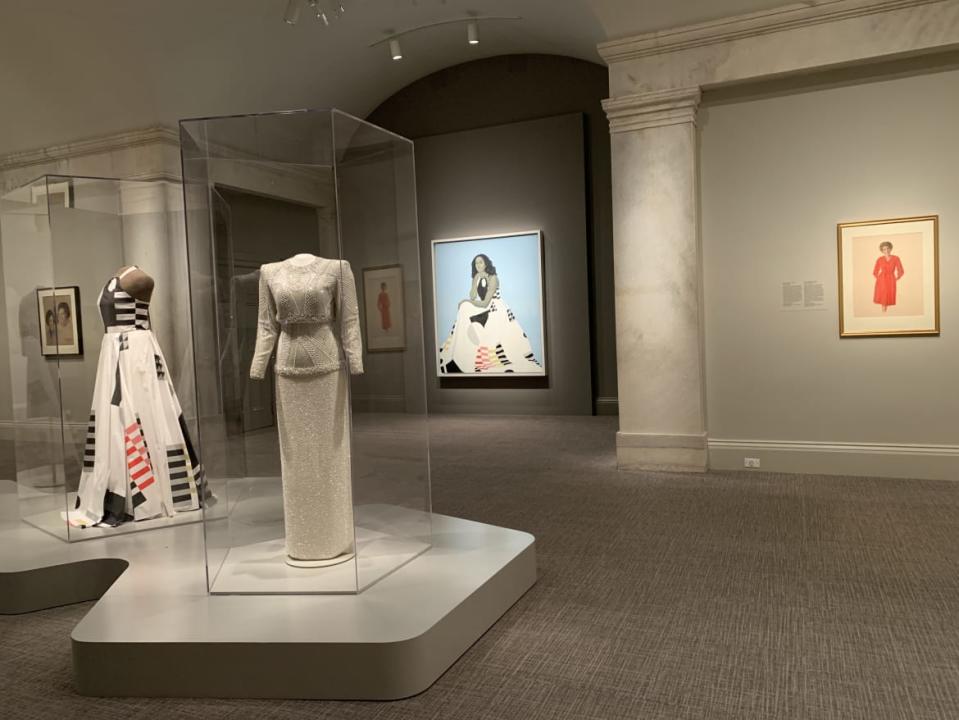
Nancy Reagan’s 1985 inaugural gown by James Galanos.
Jackie Kennedy, so enamored with her favorite French fashion houses—specifically, Chanel and Givenchy—did not want to give up her devotion once she became first lady and was encouraged to buy American-made garments. While she promoted many stateside designers, including Oleg Cassini, whose name became synonymous with Camelot, Kennedy also requested the Manhattan house Chez Ninon make copycats of the freshest looks from Paris.
“Chanel and Givenchy would approve the pattern, the fabric, the buttons, and send the materials over from Paris to Manhattan, so Chez Ninon could make her clothing,” Shaw said. “She knew the importance of having American clothes, but she would not compromise on anything else, and wanted her clothes to hit that French vision.”
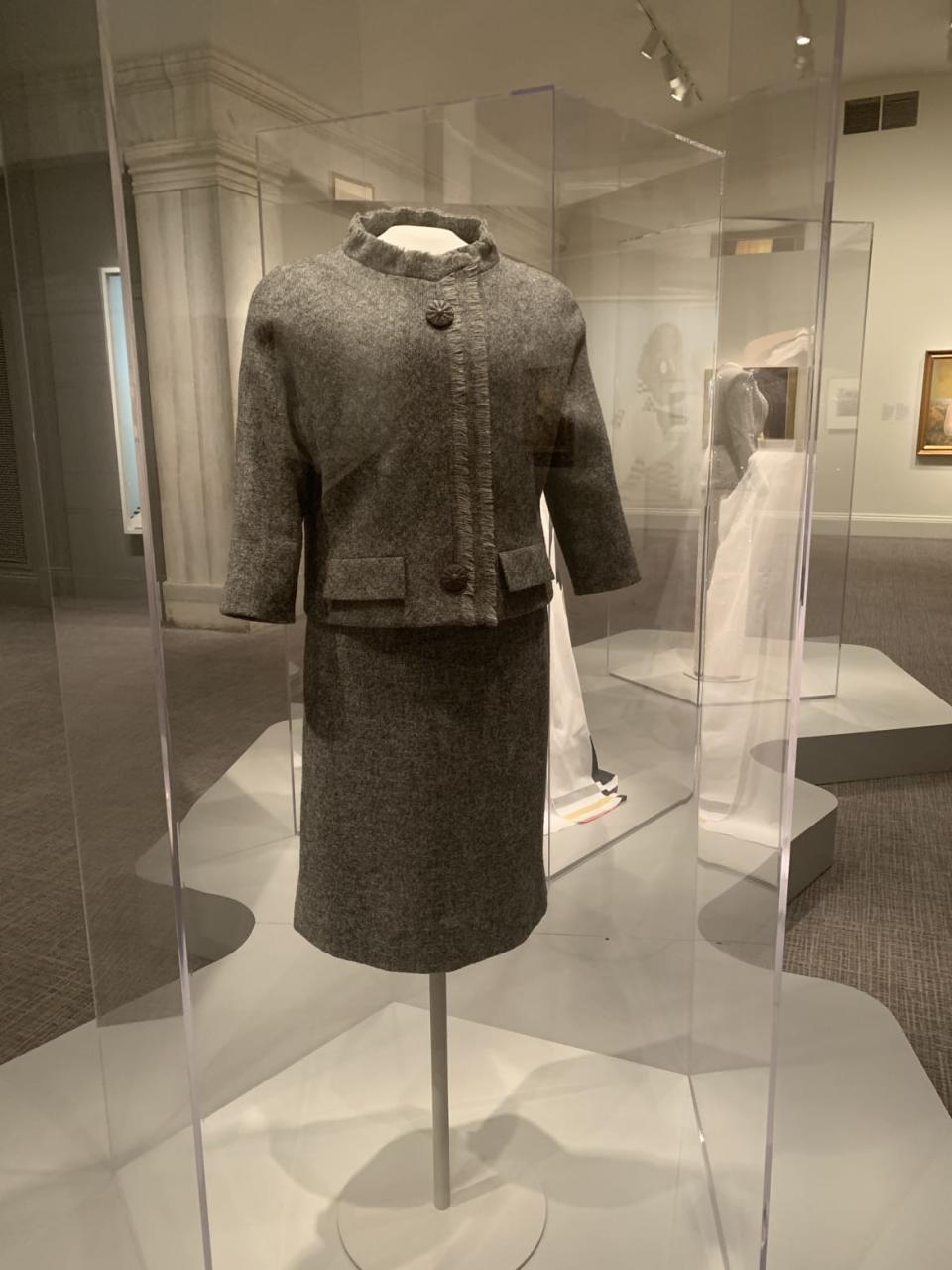
Jackie Kennedy’s gray suit by Chez Ninon, 1961.
So a gray wool tweed suit was included in the exhibit, on loan from the Kennedy Library in Boston. “It’s very conservative, but very elegant, minimalist, and really timeless—you could see someone wearing it right now,” Shaw said, speaking to Jackie’s eternal allure. “It doesn’t look like it’s 65 years old, and with that I wanted to evoke that aesthetic she became so well known for.”
Chez Ninon also likely made the pink “Chanel” copy Jackie wore to Dallas when her husband was shot, the one stained with his blood and currently out of sight in the National Archives. The exact replica of Chanel’s fall/winter 1960 garment cost $1,000, much less than the original’s $10,000.
The Milly gown Michelle Obama wore in her official White House portrait by Amy Sherald can also be seen on view in the exhibit, poised right in front of her portrait. The cotton poplin dress was from designer Michelle Smith’s spring 2017 collection; its geometric print was inspired by Gee’s Bend, a small Black community in Alabama where women have quilted since the early 1900s.
Shaw visited Michelle Smith in New York while preparing the exhibit last year; they spoke about the symbolism and significance of Obama’s portrait gown. “[Michelle Smith] really wanted to work with cotton as a fabric that everybody has in their closets someplace,” Shaw said. “It is an accessible material, and the folk quilting tradition of African American women was important to her. She wanted to have a conversation about the power of the needle in women’s lives.”
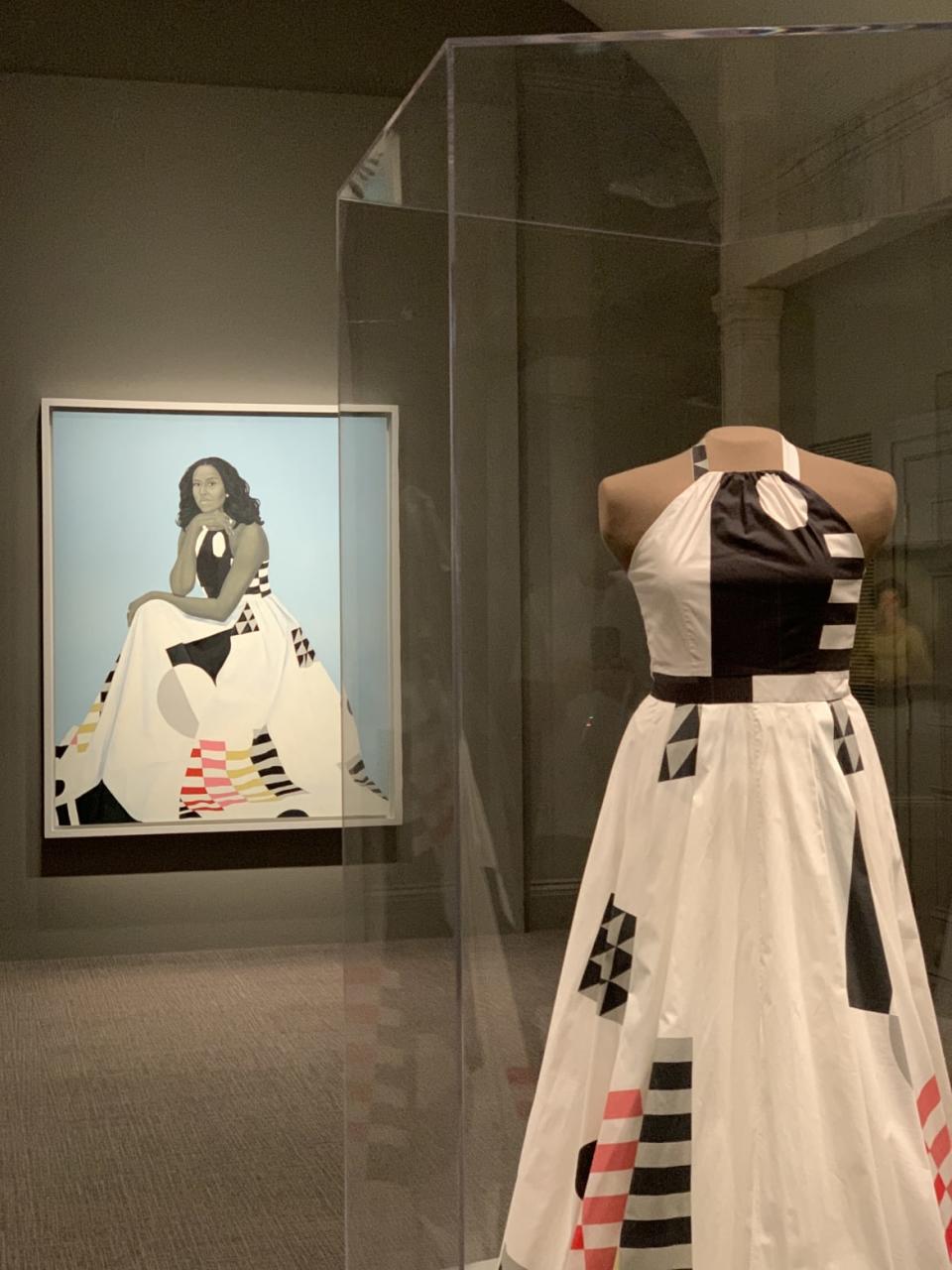
Michelle Obama’s Milly gown.
Michelle Obama “picked up on this,” Shaw explained. “She must have seen those patterns as representing American women’s work, and the visual, aesthetic contribution that women have made. That was something she wanted to honor.”
Though the original runway dress had an open back all the way down to the waist, Michelle Obama “wanted something a bit more modest,” so it was lifted into a halter neckline for her portrait.
The forms the garments are on are also part of the exhibit. Each one is made to the first lady’s unique measurement, bringing a sense of their humanity into the room.
“So many actresses have this certain cookie-cutter physical type,” Shaw said. “First ladies don’t. They were all different ages, from 21 to their early seventies when they were in the White House. All different kinds of body types. These dresses bring the presence of the first lady into the galleries in a way that the portraits only hint at. I think it’s a great reality check for people to see this.”
“Every Eye Is Upon Me: First Ladies of the United States” is on view at the Smithsonian National Portrait Gallery and online.
Get our top stories in your inbox every day. Sign up now!
Daily Beast Membership: Beast Inside goes deeper on the stories that matter to you. Learn more.

